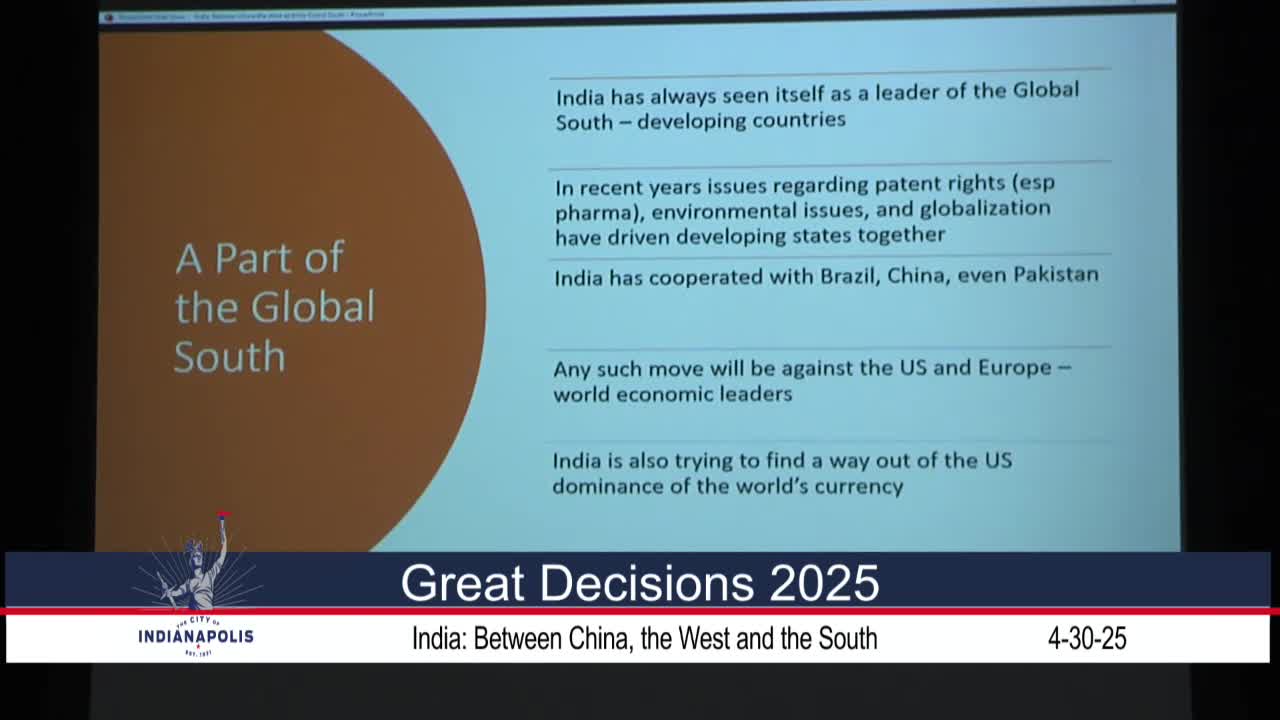Lecture: India shows economic growth and global pharma role but faces severe air pollution, climate and development challenges
May 01, 2025 | Indianapolis City, Marion County, Indiana
This article was created by AI summarizing key points discussed. AI makes mistakes, so for full details and context, please refer to the video of the full meeting. Please report any errors so we can fix them. Report an error »

Dr. Milind Takar told the audience that India’s economy has grown to be among the largest by purchasing‑power parity even as many Indians remain poor, and that Indian pharmaceutical manufacturers have played a key role supplying low‑cost medicines to lower‑income countries.
Takar said India now ranks high in overall GDP by PPP but remains low in GDP per capita (he cited an approximate global rank around 170th), which underscores persistent poverty. He described India as a large service‑sector economy rather than a manufacturing giant like China and said India still requires substantial internal reform to close development gaps.
Why it matters: Economic structure, population trends and public health problems affect millions domestically and shape India’s international economic role.
Takar highlighted the role of Indian pharmaceutical firms in reducing costs for HIV treatment. He said that an AIDS drug “cocktail” cost about $45 in the early 2000s and that Indian firms later offered equivalent combination therapies at roughly $10, substantially increasing access in parts of sub‑Saharan Africa.
On demographics, Takar cited India’s population at about 1.4 billion, noting that India currently enjoys a younger population profile while countries such as China face aging and declining populations. He described India’s population as a potential resource that requires job creation and public investment.
Takar described seasonal air pollution in and around Delhi caused by farmers burning crop residue, saying intensive smoke in late October through early December can push air quality indexes above meter limits (he noted meters may stop reading beyond 900). He attributed slow policy responses in part to political incentives favoring election messaging over administrative fixes.
He said climate impacts — higher temperatures, irregular monsoons and extreme heat events — are altering agriculture and public health, and that civic and political attention are needed to implement long‑term adaptation and pollution controls.
Takar concluded that while India has potential for further growth and global contributions, internal reform, pollution mitigation and investments in education and infrastructure are necessary to translate that potential into broad‑based improvements.
Takar said India now ranks high in overall GDP by PPP but remains low in GDP per capita (he cited an approximate global rank around 170th), which underscores persistent poverty. He described India as a large service‑sector economy rather than a manufacturing giant like China and said India still requires substantial internal reform to close development gaps.
Why it matters: Economic structure, population trends and public health problems affect millions domestically and shape India’s international economic role.
Takar highlighted the role of Indian pharmaceutical firms in reducing costs for HIV treatment. He said that an AIDS drug “cocktail” cost about $45 in the early 2000s and that Indian firms later offered equivalent combination therapies at roughly $10, substantially increasing access in parts of sub‑Saharan Africa.
On demographics, Takar cited India’s population at about 1.4 billion, noting that India currently enjoys a younger population profile while countries such as China face aging and declining populations. He described India’s population as a potential resource that requires job creation and public investment.
Takar described seasonal air pollution in and around Delhi caused by farmers burning crop residue, saying intensive smoke in late October through early December can push air quality indexes above meter limits (he noted meters may stop reading beyond 900). He attributed slow policy responses in part to political incentives favoring election messaging over administrative fixes.
He said climate impacts — higher temperatures, irregular monsoons and extreme heat events — are altering agriculture and public health, and that civic and political attention are needed to implement long‑term adaptation and pollution controls.
Takar concluded that while India has potential for further growth and global contributions, internal reform, pollution mitigation and investments in education and infrastructure are necessary to translate that potential into broad‑based improvements.
View full meeting
This article is based on a recent meeting—watch the full video and explore the complete transcript for deeper insights into the discussion.
View full meeting
